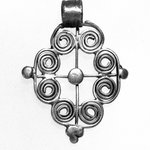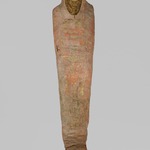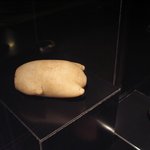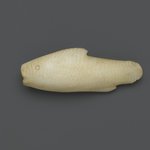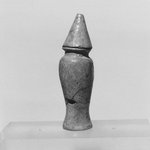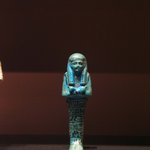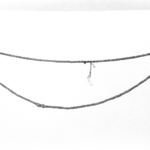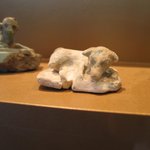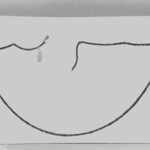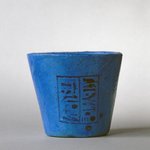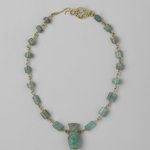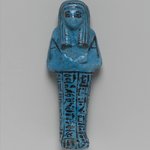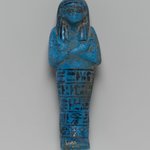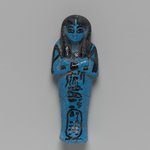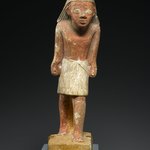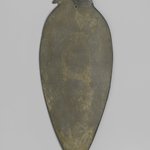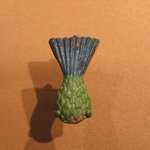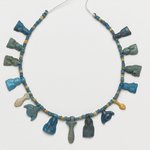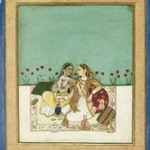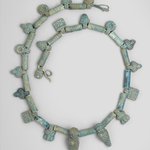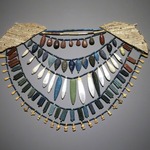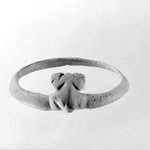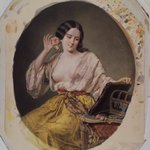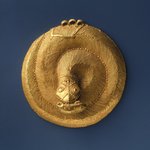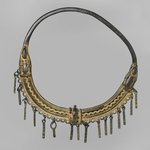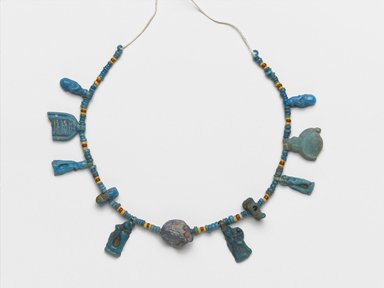

Single-Strand Necklace, ca. 1332–1292 B.C.E. Faience, 9/16 x 1/4 x 6 3/4 in. (1.4 x 0.6 x 17.1 cm). Brooklyn Museum, Gift of Mrs. Lawrence Coolidge and Mrs. Robert Woods Bliss, and the Charles Edwin Wilbour Fund, 48.66.43. Creative Commons-BY (Photo: Brooklyn Museum, 48.66.43_PS2.jpg)

Single-Strand Necklace, ca. 1332–1292 B.C.E. Faience, 9/16 x 1/4 x 6 3/4 in. (1.4 x 0.6 x 17.1 cm). Brooklyn Museum, Gift of Mrs. Lawrence Coolidge and Mrs. Robert Woods Bliss, and the Charles Edwin Wilbour Fund, 48.66.43. Creative Commons-BY (Photo: , CUR.48.66.40_35.2023_48.66.43_48.66.42_tlf.jpg)
Single-Strand Necklace
Egyptian, Classical, Ancient Near Eastern Art
Much ancient Egyptian jewelry was essentially decorative, like the pair of gold earrings shown here, which are simply thick hoops. But other items of adornment sometimes acted like amulets to protect the wearer, such as the necklaces mounted together here. These necklaces include ancestor bust figures for communicating with the dead; cornflowers, which were associated with renewal; a frog, symbolizing rebirth; and the pregnant hippopotamus, protector of pregnant women and thus a guardian of rebirth.
MEDIUM
Faience
DATES
ca. 1332–1292 B.C.E.
DYNASTY
late Dynasty 18
PERIOD
New Kingdom
DIMENSIONS
9/16 x 1/4 x 6 3/4 in. (1.4 x 0.6 x 17.1 cm) (show scale)



COLLECTIONS
Egyptian, Classical, Ancient Near Eastern Art
ACCESSION NUMBER
48.66.43
CREDIT LINE
Gift of Mrs. Lawrence Coolidge and Mrs. Robert Woods Bliss, and the Charles Edwin Wilbour Fund
CATALOGUE DESCRIPTION
Single-strand faience necklace. In center, purple glazed frog with Ma'at feather incised on base. On each side, separated by group of eleven small yellow, blue and red disk beads, five glazed amulets (uraeus, disk, cartouche, etc.). Longer section of disk beads at each end. Obviously an assembled piece.
Condition: Cartouche amulet broken. Inscription seems to read m rn.f.
MUSEUM LOCATION
This item is not on view
CAPTION
Single-Strand Necklace, ca. 1332–1292 B.C.E. Faience, 9/16 x 1/4 x 6 3/4 in. (1.4 x 0.6 x 17.1 cm). Brooklyn Museum, Gift of Mrs. Lawrence Coolidge and Mrs. Robert Woods Bliss, and the Charles Edwin Wilbour Fund, 48.66.43. Creative Commons-BY (Photo: Brooklyn Museum, 48.66.43_PS2.jpg)
IMAGE
overall, 48.66.43_PS2.jpg. Brooklyn Museum photograph, 2006
"CUR" at the beginning of an image file name means that the image was created by a curatorial staff member. These study images may be digital point-and-shoot photographs, when we don\'t yet have high-quality studio photography, or they may be scans of older negatives, slides, or photographic prints, providing historical documentation of the object.
RIGHTS STATEMENT
Creative Commons-BY
You may download and use Brooklyn Museum images of this three-dimensional work in accordance with a Creative Commons license. Fair use, as understood under the United States Copyright Act, may also apply.
Please include caption information from this page and credit the Brooklyn Museum. If you need a high resolution file, please fill out our online application form (charges apply).
For further information about copyright, we recommend resources at the United States Library of Congress, Cornell University, Copyright and Cultural Institutions: Guidelines for U.S. Libraries, Archives, and Museums, and Copyright Watch.
For more information about the Museum's rights project, including how rights types are assigned, please see our blog posts on copyright.
If you have any information regarding this work and rights to it, please contact copyright@brooklynmuseum.org.
RECORD COMPLETENESS
Not every record you will find here is complete. More information is available for some works than for others, and some entries have been updated more recently. Records are frequently reviewed and revised, and we welcome any additional information you might have.

